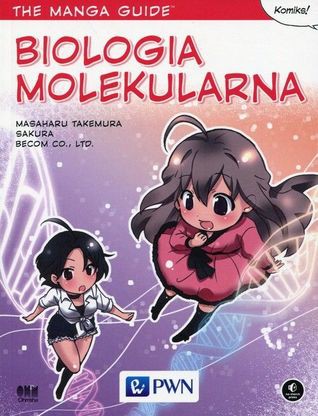Review of 'The Manga Guide to Molecular Biology' on 'Goodreads'
3 stars
My full review is here: daariga.wordpress.com/2013/01/12/the-manga-guide-to-molecular-biology/
The Manga Guide to Molecular Biology is one from the many in the manga series by No Starch Press. For a while now, I have had my eye on these English translations of works by and from Japanese. This particular manga on molecular biology is written and illustrated by Masaharu Takemura. The motivation is to use the story-telling, action-oriented and illustrative powers of the manga to introduce a science that is quite hard to grok.
Though weak and laughable, there is a story and a few principal characters here to support the cause of the manga. Ami and Rin are two students of molecular biology who have not been attending classes regularly. In order to help them, their Professor, named Moro, brings them to his private island where he has a lab. Over the next few days, his assistant Marcus uses the virtual reality machine in their lab to help these two students understand this science.
There are 5 important entities of molecular biology that the manga sets out to explain: cell, protein, DNA, RNA and gene. These entities are present in every cell of our body and are constantly in action. In every being on this planet, cells are working hard producing a myriad of proteins and are reproducing all the time. By literally taking the students (and the reader) on a trip inside the human cell, employing the virtual reality machine, the manga quite successfully brings the world of a cell to life.
I liked this manga maybe due to the fact that I did not study biology after class 10. There are a few compelling reasons why I think this manga was really good. The author has a real intuitive understanding of the science. Cells are not static, but are composed of molecules moving around and accomplishing work. The reader gets to view this action, both at the atomic-molecular level and the cellular level. Almost all textbooks restrict themselves to boring 2D figures. In this manga, we get to see how everything is organized and working in 3D. And finally, all of this content is nicely organized so that the reader is gently taken to complex concepts like DNA replication, DNA-RNA transcription and RNA-protein translation.
You might be wondering that you already know many of these concepts. So, why pick this manga? I thought so too. Here are a few tit-bits to titillate you. The cell has a cell wall. If it is a wall, how do proteins and other molecules move in and out of cells? DNA is a double-helix string. If you peek into the nucleus of a cell, will you see DNA strings floating in goo like seaweeds in water? The answer is no! Chromosomes are typically drawn as X-shaped entities. Why? During cell division, DNA replicates by making a copy of itself. If you were to zoom down to the DNA-level during replication, what would you actually see in action in front of your eyes? What is the factory-robot-like molecular machinery that is holding a DNA string, like a person holding a beaded string and methodically copying over every bead (alphabet) over to a new string? The answers to this and more will literally blow your mind!
Manga is typically read very fast. I have seen manga readers on Tokyo trains flipping a page per second. Here though, every page takes time for the mind to visualize and to imagine how the machinery moves and interacts in 3D. This manga of ~256 pages took me 2 days to read. I must also warn that the drawings, while sufficient, are not as fantastic as what is in popular manga series. Given that Takemura is a lecturer, I think this is easily forgiveable.
In conclusion, the concepts in this manga might be rudimentary for a person knowing molecular biology. But for me, it was so revealing that I had to, yet again, question the origin, the why and how of life itself. Inside every cell on this planet, is an incredibly complex molecular machinery whose working is nothing short of amazing. Pick up the manga and dive into this tiny cosmos!

